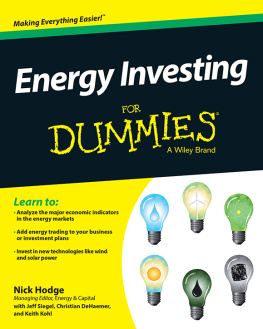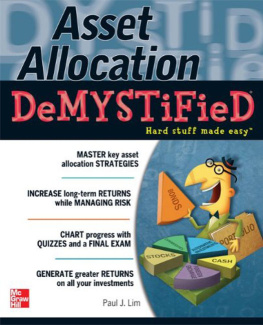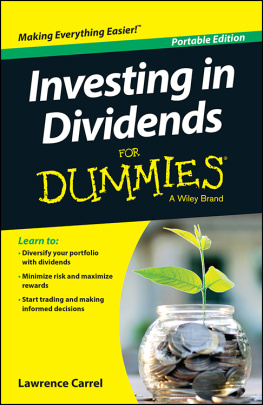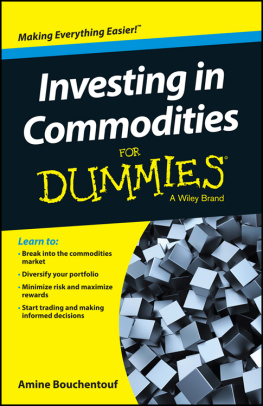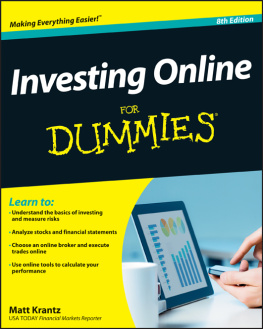Copyright 2013 by McGraw-Hill Education. All rights reserved. Except as permitted under the United States Copyright Act of 1976, no part of this publication may be reproduced or distributed in any form or by any means, or stored in a database or retrieval system, without the prior written permission of the publisher.
ISBN: 978-0-07-181275-7
MHID: 0-07-181275-X
The material in this eBook also appears in the print version of this title: ISBN: 978-0-07-181274-0, MHID: 0-07-181274-1.
E-book conversion by Codemantra
Version: 1.0
All trademarks are trademarks of their respective owners. Rather than put a trademark symbol after every occurrence of a trademarked name, we use names in an editorial fashion only, and to the benefit of the trademark owner, with no intention of infringement of the trademark. Where such designations appear in this book, they have been printed with initial caps.
McGraw-Hill Education books are available at special quantity discounts to use as premiums and sales promotions or for use in corporate training programs. To contact a representative, please visit the Contact Us page at www.mhprofessional.com.
TERMS OF USE
This is a copyrighted work and McGraw-Hill Education and its licensors reserve all rights in and to the work. Use of this work is subject to these terms. Except as permitted under the Copyright Act of 1976 and the right to store and retrieve one copy of the work, you may not decompile, disassemble, reverse engineer, reproduce, modify, create derivative works based upon, transmit, distribute, disseminate, sell, publish or sublicense the work or any part of it without McGraw-Hill Educations prior consent. You may use the work for your own noncommercial and personal use; any other use of the work is strictly prohibited. Your right to use the work may be terminated if you fail to comply with these terms.
THE WORK IS PROVIDED AS IS. McGRAW-HILL EDUCATION AND ITS LICENSORS MAKE NO GUARANTEES OR WARRANTIES AS TO THE ACCURACY, ADEQUACY OR COMPLETENESS OF OR RESULTS TO BE OBTAINED FROM USING THE WORK, INCLUDING ANY INFORMATION THAT CAN BE ACCESSED THROUGH THE WORK VIA HYPERLINK OR OTHERWISE, AND EXPRESSLY DISCLAIM ANY WARRANTY, EXPRESS OR IMPLIED, INCLUDING BUT NOT LIMITED TO IMPLIED WARRANTIES OF MERCHANTABILITY OR FITNESS FOR A PARTICULAR PURPOSE. McGraw-Hill Education and its licensors do not warrant or guarantee that the functions contained in the work will meet your requirements or that its operation will be uninterrupted or error free. Neither McGraw-Hill Education nor its licensors shall be liable to you or anyone else for any inaccuracy, error or omission, regardless of cause, in the work or for any damages resulting therefrom. McGraw-Hill Education has no responsibility for the content of any information accessed through the work. Under no circumstances shall McGraw-Hill Education and/or its licensors be liable for any indirect, incidental, special, punitive, consequential or similar damages that result from the use of or inability to use the work, even if any of them has been advised of the possibility of such damages. This limitation of liability shall apply to any claim or cause whatsoever whether such claim or cause arises in contract, tort or otherwise.
This book is dedicated to my children,
Spencer and Brianna. Hopefully, they will enjoy the
written word as much as they enjoy science and math.
This book is also dedicated to my wife, Angela,
who has taken care of everything while I spent time writing.
About the Author
Davis W. Edwards, FRM, ERP, is a senior manager in Deloitte & Touches National Securities Pricing Center managing energy derivatives valuation. Prior to joining Deloitte, he was division director of credit risk at Macquarie Bank and senior managing director on the statistical arbitrage trading desk at Bear Stearns. He is a regular speaker on the topic of financial modeling and mathematics applied to real-world problems. He is the author of the book, Energy Trading and Investing, and the director of the Houston chapter of the Global Association of Risk Professionals.

Contents
Introduction
Energy products have become some of the most heavily traded commodities in the world following deregulation in the gas, oil, and electricity industries in the late 20th century. Prior to deregulation, prices were set by governments or other regulatory agencies. Along with slowing innovation and reducing efficiency, this limited private investments in these industries. As these markets were deregulated, opportunities for small investors multiplied. Currently, there are an abundance of trading and investing opportunities in the energy markets.
Deregulation has not ended government involvement in the energy industry. It merely changed how this involvement is manifested. The energy industry remains one of the most highly regulated industries in the world. Regulations exist at the international, national, and local levels. In many cases, these regulations have conflicting goals. For example, affordable energy has fueled human progress for the past century, eliminating poverty and improving living conditions for many people. However, this has come at the price of increased pollution and the risk of global warming. This can lead to diverging energy policies at different levels of government.
CHAPTER OBJECTIVES
After completing this chapter, the student should have an understanding of
Investing
The role of regulation of energy markets
How to Use this Book
This book is intended to be both a reference manual and a training course. It is patterned after training courses given to traders and professional investors by energy companies, hedge funds, and investment banks when they first start working on a trading desk. The purpose of this book is to give the reader the same level of knowledge as a professional trader or energy investor might possess on these topics. After reading this book, the reader should have a solid understanding of the products, infrastructure, and industries that make up the energy market.
To first time investors, it might seem odd that this book spends so much time explaining the details of the financial markets that can help someone become a good investor. Initially, it might seem unfair that someone armed with a how-to book should be competing for investment opportunities with MBAs and PhDs from top schools, educated and provided with the best data that money can buy. However, it can be doneand done successfully.
One key is to do your own work. By the time a broker is calling about investment opportunities, there probably isnt a lot of opportunity left. Hundreds of thousands of other smart people have had the chance to look at the opportunity first. Easy profit opportunities disappear pretty quickly, and what gets left over is not always that appealing. Knowing about what is actually going on in the industry allows you to understand trends when they start forming. It dramatically increases the chance of finding a good opportunity early.
However, thats only part of the investing story. What tends to get missed in investing is the concept of risk. Trading isnt always about finding good opportunities. Largely, its a matter of avoiding bad opportunities. If an investor can avoid losing money, most of the other outcomes look pretty good. The better an investor is able to avoid large losses, the more likely they are to be successful in the long run. The key to avoiding investment disasters lies in understanding the details of the industry



